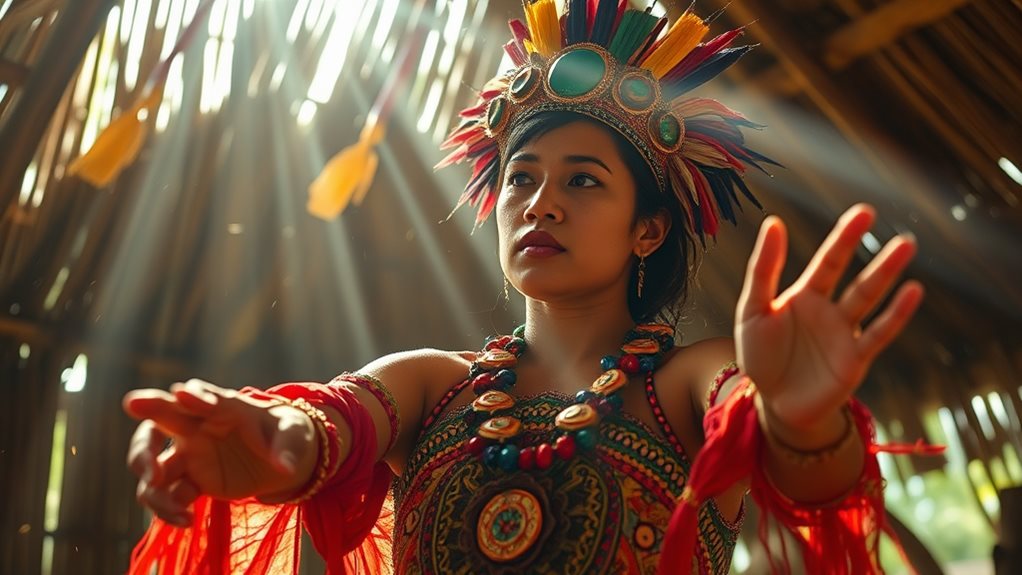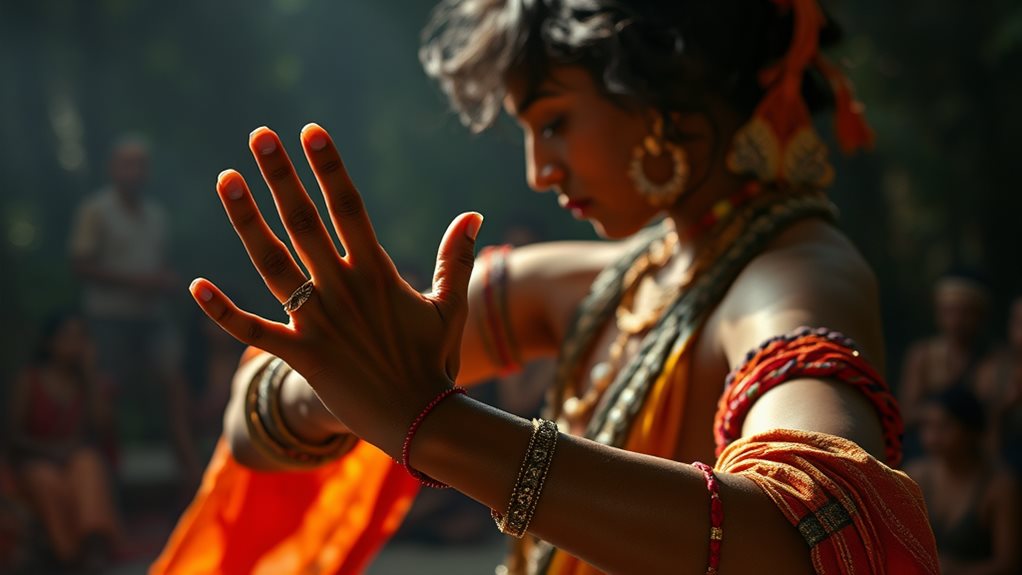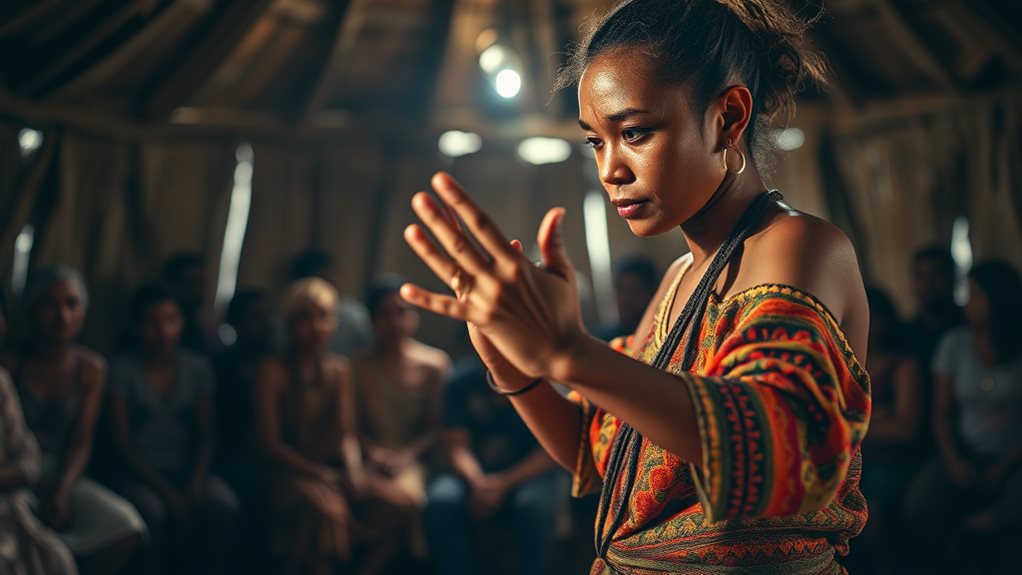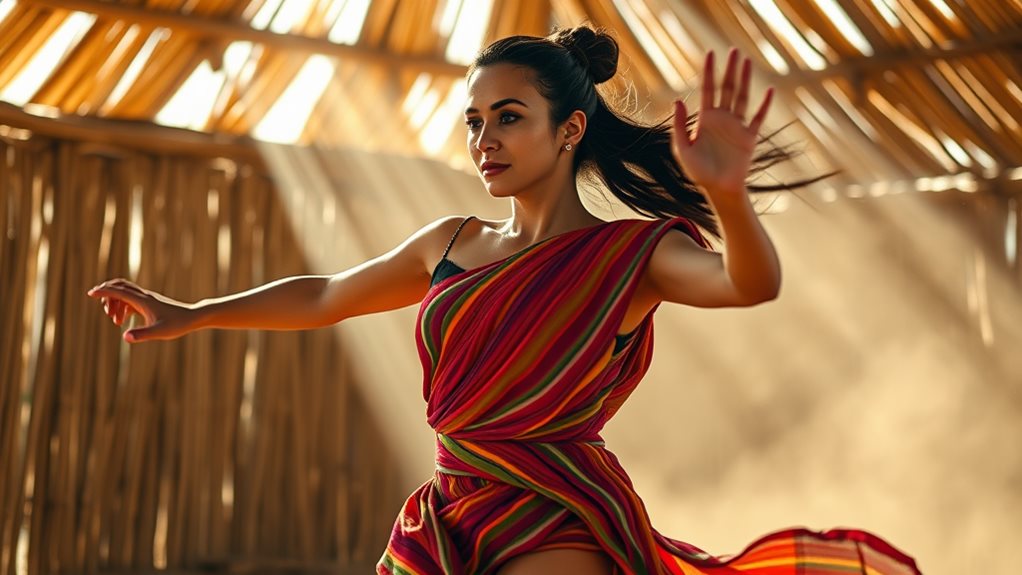Dance plays a crucial role in Filipino indigenous healing practices. It connects individuals to the spiritual world and fosters community well-being.
In these practices, specific dances like *Binaylan* showcase humility and gratitude. This dance is performed to honor the gods and the community, promoting spiritual growth and harmony.
Other dances, such as *Dugso*, actively dispel negative energies****. This is achieved through the use of rhythmic movements and traditional instruments, which promote emotional release and balance.
These healing practices address mental, emotional, and spiritual health needs. They integrate seamlessly with thanksgiving and blessing ceremonies, offering a holistic approach to well-being.
The interwoven significance of these traditions highlights their therapeutic power. The connection between dance, spirituality, and community is a key factor in the effectiveness of these healing practices.
Traditional Filipino Dances

The Philippines' rich cultural heritage is reflected in its diverse indigenous dances**, each showcasing unique regional identities and historical influences. Dance symbolism** plays a crucial role in conveying narratives, emotions, and cultural values.
Luzon's dances, such as the Pandanggo sa Ilaw, require balancing lamps, while the Itik-Itik mimics a duck. These dances blend indigenous and Spanish influences, demonstrating regional variations. The Tinikling demands precision and agility with its intricate steps between bamboo poles, whereas the Sayaw sa Bangko highlights balance and acrobatic skill.
In the Visayas region, the Cariñosa is a courtship dance using handkerchiefs, while the Kuratsa is a three-part courtship dance that depicts a waltz, chase, and mating ritual. The Pantomina, or "Dance of the Doves," simulates bird courtship through symbolic movements.
La Jota Moncadeña reflects the cultural exchange with Spain, combining Spanish and Ilocano steps.
Mindanao boasts unique dance styles, including the Singkil, which narrates the epic "Darangan" with precise footwork around bamboo poles. The Pangalay, a Tausug dance, displays intricate hand movements that mirror the fluidity of water and the flight of birds.
These regional variations in dance symbolism, form, and function demonstrate the Philippines' rich cultural diversity and heritage.
Cultural and Historical Background
Filipino indigenous healing practices have a complex and rich history, shaped by various cultural influences and historical events.
The development of these practices reflects a blend of cultural traditions and influences that predate both Islam and Christianity. Ancient rituals, such as the Maguindanaon Sagayan dance and Ipat ritual, demonstrate the enduring legacy of indigenous healing in the Philippines.
Pre-colonial traditions were influenced by Chinese, Indian, Indonesian, Malay, Spanish, and American cultures. This is evident in the southern Philippines, where Hindu, Arabic, and Indo-Malayan influences are particularly noticeable. The integration of these cultural influences further shaped the indigenous healing practices.
Spanish colonization introduced Western elements to Filipino healing practices, but indigenous methods persisted. This was especially true in remote communities, where traditional healing practices continued to be used. The persistence of these practices highlights the enduring strength of Filipino cultural and religious beliefs.
Understanding the cultural influences on Filipino indigenous healing is crucial to appreciating the nuances of these practices. The blend of indigenous and external elements created unique healing practices that incorporate spiritual and physical elements. For example, the Sagayan dance combines spiritual and physical elements to promote healing and well-being.
Analyzing the historical and cultural factors that have shaped Filipino indigenous healing is essential to understanding its complex role in dance. By examining the evolution of these practices over centuries, we can gain a deeper understanding of the adaptability and resilience of Filipino culture.
Healing Rituals and Dances

Indigenous healing rituals and dances in the Philippines are deeply rooted in spiritual and physical practices, reflecting the cultural beliefs and social structures of various communities.
The Aeta's *Anituan* ritual, for example, is a group healing session where participants are covered with a red cloth, symbolizing illness, to facilitate contact with benevolent spirits. This dramatic performance is characterized by its trance-like quality and powerful healing symbolism.
In the Mamanwa community, the *Binaylan* or *Tinambajon* dance is performed by a healer and involves offerings to the gods and spirit possession. The dance showcases steps expressing humility and gratitude, accompanied by the percussive sounds of the *gimbar/gimbe-e* and gong, which strengthen the spiritual connection between the healer and the divine.
Dance plays a vital role in healing practices among Cordillera communities, as seen in the *Cañao* rituals. These dances, performed with sticks and gongs, alongside prayers and offerings, aim to gain the favor of supernatural beings, reflecting the community's values.
The Higaonon's *Dugso*, a sacrifice dance, utilizes vibrant costumes and rhythmic movements to dispel negative spirits and promote well-being****. This dance is often performed during thanksgiving and blessing ceremonies, forging a strong spiritual connection with the community.
Dance Music and Instruments
Filipino Traditional Dance Music and Instruments
Traditional Filipino dances are accompanied by a rich tapestry of music produced by diverse instruments reflecting the archipelago's unique cultural heritage. The specific instruments used vary greatly depending on the region and the specific dance.
Gongs are a key element in Filipino traditional dance music. Kulintang and agung gongs provide a powerful, resonant foundation, while smaller gongs like the babendil add intricate details to the rhythmic patterns.
Drums, including the dabakan, libbit, and sulibao, contribute a driving pulse with tonal qualities ranging from deep resonance to sharp, percussive accents. For example, the dabakan drum is a single-headed drum that provides a deep, resonant sound, while the libbit drum is a double-headed drum with a sharper, more percussive sound.
Stringed instruments, such as the kudyapi and various lutes, introduce melodic lines and textures to the music. The kudyapi is a two-stringed lute that produces a melancholic sound, while other lutes can produce celebratory sounds depending on the context.
Bamboo instruments like the bansik and gabbang add a unique timbre to the music, contrasting with the metallic clang of gongs and the rhythmic thud of drums.
These dance instruments are integral to the healing process in Filipino traditional dances. The rhythmic patterns generated by these instruments often mimic the heartbeat or the cyclical nature of life, creating a hypnotic effect that aids in trance-inducing rituals.
The interplay between the instruments and the dance movements creates a powerful synergy, fostering a deep connection between the dancer, the music, and the spiritual realm.
Community and Social Roles

Traditional Filipino music and dances play a significant role in shaping community life and social structures. They extend beyond therapeutic applications, profoundly impacting community bonding and social cohesion. For instance, in dances like the Dinugso, participants join hands to form a circle, symbolizing the tribe's unity and shared reverence for ancestral beliefs.
These dances are crucial for collective healing and social bonding. They provide a space for congregation and emotional expression, as seen in the Higaonon's Kaligaon festival. Ancestor veneration, a vital aspect of many dances, ensures the community's well-being and spiritual protection. This is evident in the ritual significance of every movement, which permeates every dance.
The dances also contribute to cultural preservation. By wearing traditional costumes and passing down knowledge through generations, cultural identity is maintained. Researchers employ methods like Francisca Reyes-Aquino's notation system to document and preserve these intricate movements, ensuring continued cultural transmission. This educates younger generations about their heritage, promoting community pride.
The dances reflect historical events and myths, and are integrated into life-cycle events. For example, the Singkil dance is connected to the Maranao epic, and dances are performed at weddings and harvest celebrations. This reinforces community values and provides a framework for understanding the past, present, and future.
The dances are a living testament to the interwoven nature of healing, spirituality, and social cohesion in Filipino indigenous communities.
Dance as a Performance Art
Filipino Indigenous Dances as a Performance Art****
Filipino indigenous dances function as a powerful performance art, deeply intertwined with ritual, spirituality, and social life. These performances are vibrant expressions of cultural identity that serve as a form of expressive storytelling.
The intricate choreography in these dances reflects deep spiritual beliefs. For instance, the traditional Tinikling dance from the Visayan region involves quick steps and footwork between bamboo poles, symbolizing the struggle between good and evil.
Traditional costumes and props also enhance the narrative. The colorful attire and adornments worn by the dancers, such as the Ifugao people's bahag and tapis, hold symbolic meanings that add to the story being told.
Music plays a vital role in setting the mood and guiding the dancers. Traditional instruments like gongs and drums create a captivating rhythmic expression that underpins the dance. The Sakuting dance, a war dance from the Mountain Province, features the use of gongs and drums to simulate the sounds of war, creating an intense atmosphere.
The incorporation of props adds layers of meaning to the expressive storytelling. For example, the use of spears and votive torches in the Sagayan dance from the Maranao people serves as a representation of their rich history and cultural heritage.
The skillful incorporation of traditional instruments and costumes, combined with complex choreography and rhythmic coordination between dancers and musicians, creates a unified and powerful performance.
This dynamic interplay between music, movement, and symbolism showcases the dances' role as a powerful performance art form deeply rooted in Filipino indigenous culture.
The Significance of Edel Dance

The Edel Dance serves as a therapeutic tool for the bereaved in the Tagakaulo tribe of Davao Occidental. Performed three days after a burial, it plays a crucial role in their healing process. This dance embodies the tribe's holistic worldview, combining physical, emotional, and spiritual well-being.
The Edel Dance intertwines with the tribe's afterlife beliefs. It isn't just a mourning ritual but a means to connect with ancestral guidance. Three women perform the dance with votive torches, while men play the udol, a long wooden instrument, creating a rhythmic backdrop for their movements. The dance reflects the women's grief, with the men's frenzied movements symbolizing the release of raw emotion.
A male priest plays a vital role in the Edel Dance. He invokes spirits to guide the deceased's soul, strengthening the spiritual connection at the heart of the ritual. The "pasapling" practice, smelling plants and flowers, adds a sensory dimension to the complex ritual.
The Edel Dance isn't just about commemorating death; it's about emotional release and restoring balance. It's a testament to the Tagakaulo tribe's deep-seated belief in the interconnectedness of the physical and spiritual realms.
Through the Edel Dance, we witness how dance facilitates healing and strengthens community bonds in the face of loss, providing a channel for grief to be processed and reinforcing their faith in a peaceful afterlife.
Preservation of Indigenous Dances
Preserving Filipino Indigenous Dances Requires a Multi-Faceted Approach
Filipino indigenous dances are deeply rooted in tribal life, serving as vital expressions of beliefs and significant life events. To protect these dances, we must address cultural practices, community involvement, historical context, and documentation efforts.
Cultural Significance and Community Involvement
These dances are performed to honor ancestors, seek blessings, and ward off misfortune****. Elders play a crucial role in ensuring the continuity of these dances by passing them down to younger generations.
Community involvement is key to preserving this heritage, as family participation in these dances ensures knowledge transfer across generations. Supporting initiatives that promote cultural transmission through active teaching and learning can help preserve these traditions.
Historical Context and Cultural Influences****
Understanding the historical context of Filipino indigenous dances is crucial, as they've been impacted by interactions with various cultures.
However, these dances have retained their core essence, often predating colonial influence. For example, the Tinikling dance, which originated in the Visayas region, is a traditional dance that has been influenced by Spanish and American cultures but still maintains its originality.
Documentation and Preservation Efforts****
Systematic dance documentation is vital to preserving these traditions. This includes written records and research, as well as visual documentation such as films and photographs that capture the subtleties of movement, costume, and context.
Educational programs that incorporate these documentation efforts contribute significantly to the preservation and understanding of these invaluable cultural treasures. By actively engaging in these processes, we can ensure that these dances thrive for generations to come.
The Future of Dance Healing

Preserving Traditional Dance Healing for Future Generations****
The preservation of traditional dances requires considering their future application in healing practices. Integrating traditional Filipino dance healing with Western and Eastern holistic approaches is essential for its future application. This blending of approaches can be seen in therapeutic encounters that bridge indigenous and Western healing methods, particularly in addressing trauma through dance. For instance, the use of Filipino dance healing in conjunction with Western techniques can create a unique approach to trauma recovery.
Facilitating Cultural Exchange and Community Engagement****
Facilitating cultural exchange between local healers and international practitioners is crucial for incorporating dance healing into broader health strategies. Community engagement is key to ensuring cultural sensitivity and effectiveness in program development. Local communities should be involved in program development to ensure that the practices are culturally sensitive and effective. By doing so, the programs can foster holistic well-being, encompassing physical, emotional, and spiritual dimensions.
Leveraging Technological Advancements****
Technological advancements offer exciting possibilities for preserving and promoting traditional dance healing. Utilizing digital technologies to document and archive these invaluable dances is essential for their preservation. Virtual workshops and online training programs can be developed to disseminate these practices globally. For example, mobile health applications can be created to incorporate indigenous dance rituals and movements, and dance healing can be integrated into telehealth services to broaden access.
Formal Education and Training
Formal educational programs should incorporate indigenous dance healing into curricula for future healthcare professionals. Establishing structured apprenticeship programs under experienced healers is vital for the transmission of knowledge. Workshops and seminars can be organized for practitioners to learn about indigenous dance healing. Interdisciplinary research, combining anthropology, health sciences, and dance studies, can provide a comprehensive understanding of dance healing. Certification programs can be developed to ensure high standards and authenticity.
Community-Based Initiatives and Cultural Revitalization****
Community-based initiatives promoting dance healing, combined with robust social support networks, are essential for long-term success. Leveraging dance healing for cultural revitalization can help preserve indigenous practices and promote cultural understanding. Integrating faith and spirituality, central to many indigenous practices, into community health programs can achieve holistic well-being. By doing so, dance healing can become a vital component of community health programs.
Questions and Answers
How Are Dancers Chosen for Healing Rituals?
Dancers are chosen for healing rituals based on a combination of factors. Their lineage, dancing skills, and understanding of the dance's cultural significance play a crucial role in the selection process.
In many traditional societies, spiritual connection and community approval are also essential for becoming a ritual dancer. For instance, in some Indigenous cultures, ritual dancers must demonstrate their ability to connect with the spiritual realm and receive guidance from elders and community leaders. Spiritual connection and community approval are vital for a dancer's selection, as they ensure the dancer's ability to perform the ritual effectively and respectfully.
Are There Age Restrictions for Participation?
There are no strict age limits for participation. This is due to the cultural significance of intergenerational involvement, where elders take on leadership roles and youth participate in the learning process. As a result, all community members, regardless of age, are encouraged to contribute to community healing.
What Happens if a Ritual Fails?
Ritual failure can have severe consequences on the community and individuals involved.
When a ritual fails, it can lead to a diminished sense of significance and impact the community's response to the event. This, in turn, can cause strained relationships among community members and create spiritual unrest. As a result, the community may reevaluate their practices and question their effectiveness.
Strained relationships and spiritual unrest can lead to health and emotional consequences. For example, community members may experience anxiety, depression, or feelings of guilt and shame. They may also become withdrawn or isolated, which can further exacerbate the negative effects of the ritual failure.
Reevaluating practices can be a positive outcome of ritual failure. By examining what went wrong and how to improve, the community can refine their practices and create a more meaningful and effective ritual experience. This process can help to rebuild relationships and restore spiritual balance within the community.
Do All Tribes Use Similar Healing Dances?
Tribal healing dances are not uniform and instead reflect the distinct cultural practices of each tribe. Each tribe's healing dance possesses unique cultural significance, reflecting diverse beliefs and practices. For example, in some Native American tribes, the Sun Dance is performed to promote healing and spiritual growth, while in other tribes, the Ghost Dance is performed to communicate with spirits and seek guidance.
How Is Dance Training Passed Down?
Dance training is passed down through various methods.
Traditionally, dance techniques are learned through apprenticeships, where an experienced dancer guides a novice. This hands-on approach allows the student to learn by observing and imitating the mentor's movements. For example, a young ballet dancer might train under the supervision of a renowned ballet master to master the art.
Mentorship is another key factor in passing down dance knowledge. An experienced dancer shares their expertise and provides personalized feedback to the student. This close relationship enables the student to refine their skills and develop their unique style. For instance, a contemporary dancer might work with a choreographer to learn specific techniques and perfect their performance.
Oral traditions also play a significant role in preserving dance heritage. Dancers pass down stories, legends, and historical context through verbal accounts, ensuring the cultural significance of the dance is maintained. Community involvement is essential in this process, as it allows dancers to share their knowledge and learn from one another. For example, traditional folk dancers might gather to share their experiences and teach each other new steps, refining their skills through collective practice.